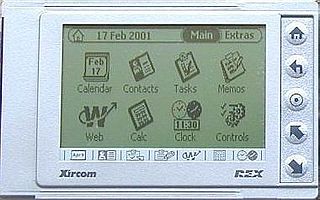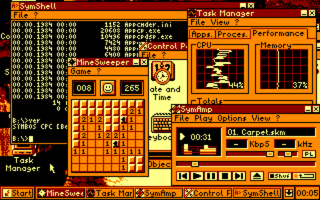Related Research Articles

The Amstrad CPC is a series of 8-bit home computers produced by Amstrad between 1984 and 1990. It was designed to compete in the mid-1980s home computer market dominated by the Commodore 64 and the ZX Spectrum, where it successfully established itself primarily in the United Kingdom, France, Spain, and the German-speaking parts of Europe.

The Z80 is an 8-bit microprocessor introduced by Zilog as the startup company's first product. The Z80 was conceived by Federico Faggin in late 1974 and developed by him and his 11 employees starting in early 1975. The first working samples were delivered in March 1976, and it was officially introduced on the market in July 1976. With the revenue from the Z80, the company built its own chip factories and grew to over a thousand employees over the following two years.
Amstrad was a British electronics company, founded in 1968 by Alan Sugar at the age of 21. The name is a contraction of Alan Michael Sugar Trading. It was first listed on the London Stock Exchange in April 1980. During the late 1980s, Amstrad had a substantial share of the PC market in the UK. Amstrad was once a FTSE 100 Index constituent, but since 2007 has been wholly owned by Sky UK. As of 2006, Amstrad's main business was manufacturing Sky UK interactive boxes. In 2010, Sky integrated Amstrad's satellite division as part of Sky so they could make their own set-top boxes in-house.

BBC BASIC is a version of the BASIC programming language released in 1981 as the native programming language for the BBC Micro home/personal computer, providing a standardized language for a UK computer literacy project of the BBC. It was written mainly by Sophie Wilson.
Microsoft BASIC is the foundation software product of the Microsoft company and evolved into a line of BASIC interpreters and compiler(s) adapted for many different microcomputers. It first appeared in 1975 as Altair BASIC, which was the first version of BASIC published by Microsoft as well as the first high-level programming language available for the Altair 8800 microcomputer.

The Franklin REX 5, was one of the Rex line of Personal Digital Assistants, each a PCMCIA PC card and thus the size of a credit card, built around a Toshiba microprocessor emulating a Zilog Z80. The REX firmware was written by Starfish Software, and the hardware was manufactured by Citizen Electronics. Earlier models in this line had almost no input possibilities except to download data when installed in a host computer or in a docking station; the Rex 5 added a sixth button and introduced a modal input method. Further, with 512 KB of RAM, the Rex 5 had twice the memory of the Rex-3.

The REX 6000 is an ultra-thin Personal Digital Assistant (PDA) produced by Xircom, and later Intel, from about 2000 to 2001. Its primary claim to fame is as "The world's smallest full-function PDA", due to its unusual physical configuration as a PC card Type-II card. The REX may be synchronized by inserting it in a host PC's PCMCIA/PC-card slot. Docking stations were manufactured for connection to hosts without PC card Type-II slots, which allows the REX to be connected via a USB or serial connection.
4-bit computing is the use of computer architectures in which integers and other data units are 4 bits wide. 4-bit central processing unit (CPU) and arithmetic logic unit (ALU) architectures are those that are based on registers or data buses of that size. A group of four bits is also called a nibble and has 24 = 16 possible values.

The TI-84 Plus is a graphing calculator made by Texas Instruments which was released in early 2004. There is no original TI-84, only the TI-84 Plus, the TI-84 Plus Silver Edition models, and the TI-84 Plus CE. The TI-84 Plus is an enhanced version of the TI-83 Plus. The key-by-key correspondence is relatively the same, but the TI-84 features improved hardware. The archive (ROM) is about 3 times as large, and the CPU is about 2.5 times as fast. A USB port and built-in clock functionality were also added. The USB port on the TI-84 Plus series is USB On-The-Go compliant, similar to the next generation TI-Nspire calculator, which supports connecting to USB based data collection devices and probes, and supports device to device transfers over USB rather than over the serial link port.

Pocket Viewer was a model range of personal digital assistants (PDAs) developed by Casio around the turn of the 21st Century.

The TRS-80 Model 100 is a portable computer introduced in April 1983. It is one of the first notebook-style computers, featuring a keyboard and liquid-crystal display, in a battery-powered package roughly the size and shape of a notepad or large book. The 224-page, spiral-bound User Manual is nearly the same size as the computer itself.

The Epson QX-10 is a microcomputer running CP/M or TPM-III which was introduced in 1983. It was based on a Zilog Z80 microprocessor, running at 4 MHz, provided up to 256 KB of RAM organized in four switchable banks, and included a separate graphics processor chip (µPD7220) manufactured by NEC to provide advanced graphics capabilities. In the USA and Canada, two versions were launched; a basic CP/M configuration with 64 KB RAM and the HASCI configuration with 256 KB RAM and the special HASCI keyboard to be used with the bundled application suite, called Valdocs. TPM-III was used for Valdocs and some copy protected programs like Logo Professor. The European and Japanese versions were CP/M configurations with 256 KB RAM and a graphical Basic interpreter.

The PC-9800 series, commonly shortened to PC-98 or 98, is a lineup of Japanese 16-bit and 32-bit personal computers manufactured by NEC from 1982 to 2000. The platform established NEC's dominance in the Japanese personal computer market, and, by 1999, more than 18 million units had been sold. While NEC did not market these specific machines in the West, it sold the NEC APC series, which had similar hardware to early PC-98 models.
This is an incomplete list of assemblers: computer programs that translate assembly language source code into binary programs. Some assemblers are components of a compiler system for a high level language and may have limited or no usable functionality outside of the compiler system. Some assemblers are hosted on the target processor and operating system, while other assemblers (cross-assemblers) may run under an unrelated operating system or processor. For example, assemblers for embedded systems are not usually hosted on the target system since it would not have the storage and terminal I/O to permit entry of a program from a keyboard. An assembler may have a single target processor or may have options to support multiple processor types. Very simple assemblers may lack features, such as macros, present in more powerful versions.
Programmable calculators are calculators that can automatically carry out a sequence of operations under control of a stored program. Most are Turing complete, and, as such, are theoretically general-purpose computers. However, their user interfaces and programming environments are specifically tailored to make performing small-scale numerical computations convenient, rather than general-purpose use.

SYmbiosis Multitasking Based Operating System (SymbOS) is a multitasking operating system for Zilog Z80-based 8-bit computer systems.
The Small Device C Compiler (SDCC) is a free-software, partially retargetable C compiler for 8-bit microcontrollers. It is distributed under the GNU General Public License. The package also contains an assembler, linker, simulator and debugger. As of March 2007, SDCC is the only open-source C compiler for Intel 8051-compatible microcontrollers. In 2011 the compiler was downloaded on average more than 200 times per day.
S-OS is a simple operating system mainly for Z80 based computers. The operating system was first presented in 1986 in the Japanese magazine Oh!X in an article called "The Sentinel".
References
- ↑ "Creating a Z80 Development Environment". www.allthingsmicro.com. Archived from the original on 11 February 2017. Retrieved 14 January 2022.
- 1 2 Z88DK Supported Targets
- ↑ Vintage is the New Old: Z88DK – Development kit for Z80 gets new version
- ↑ futurice: Build environment like it's 1986